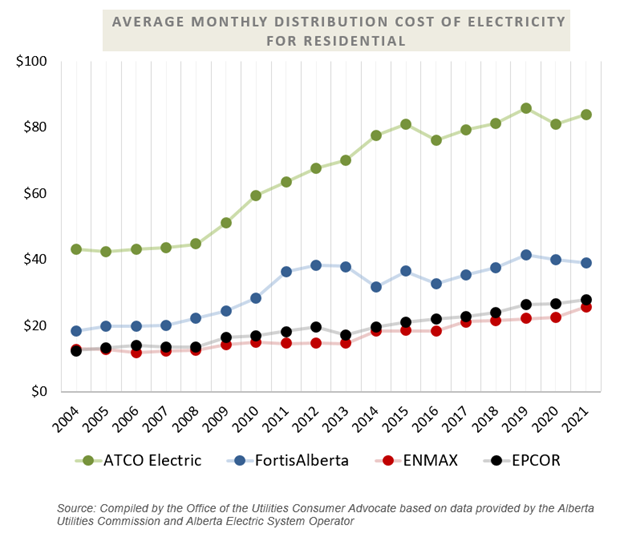Disparity in Electricity Distribution and Transmission Rates
IT IS THEREFORE RESOLVED THAT Alberta Municipalities advocate for the Government of Alberta to eliminate the disparity in electricity pricing for transmission and distribution charges across the Province by adopting a model similar to British Columbia or Saskatchewan.
WHEREAS the cost of transmission and distribution of electricity to customers is causing a disparity in prices across Alberta;
WHEREAS electricity prices, which are becoming extraordinarily high in some service areas, are regulated by the Alberta Utilities Commission (AUC) for residential, farm and commercial customers in rural and urban areas;
WHEREAS in 2021, annual transmission charges paid by the average residential customer with 7200 kWh of consumption ranged from $239.28 (in Enmax’s service area) to $339.72 (in ATCO’s service area)1;
WHEREAS in 2021, annual distribution charges paid by the average residential customer with 7200 kWh of consumption ranged from $308.40 (in ENMAX’s service area) to $1,007.16 (in ATCO’s service area) 2; and
WHEREAS the cost of transmission and distribution do not just impact purchased energy but also sold energy, with high costs making micro-generation economically challenging in much of the Province.
Because electricity delivery is a fully regulated service, the Alberta Utilities Commission (AUC) reviews the costs in detail and approves the rates to ensure all the charges are fair and reasonable. However there seems to be a disparity in these charges depending on where you live in Alberta. Energy delivery charges include two components: transmission and distribution (in addition to rate riders).
Transmission charges cover the cost of moving electric energy from generating facilities through transmission lines to distribution utility substation transformers. The transmission charge on an electricity bill is based on how much electricity the customer has used and on average is between 14% and 20% of a customer’s total bill.
Distribution costs vary with location and consumption. Distribution charges cover the cost of moving electric energy from substation transformers through local lines that carry electricity to the customers’ meters. If the service area is large and sparsely populated, one kilometer of distribution line may only serve a few customers whereas in an urban centre, one kilometer of line serves a larger number of customers. Distribution charges are between 22% and 47% of a customer’s total bill.
In some parts of the Province, energy delivery charges compose nearly 70% of a customer’s total bill for the sum of the two components: transmission and distribution charges.
In large geographical portions of the Province, both businesses and residential endure economic penalties based on geographical and population density disadvantages. This disadvantage can be as high as a 3 to 1 ratio of as seen in chart comparisons below. In comparison, British Columbia and Saskatchewan have succeeded in building and operating transmission and distribution systems where landed costs of electricity are much more evenly distributed amongst the entire system.
In Saskatchewan, all cities, towns and villages pay one rate that includes transmission and distribution costs regardless of geographic location and all rural areas pay a marginally higher rate. There is only a 1.4 to 1 ratio between the two rates. In British Columbia, all electricity costs including transmission and distribution are equalized across the entire Province.
As the electrical grid for Alberta ultimately operates as a single entity, it is reasonable to distribute those costs equally across the Province. The current system unfairly penalizes communities that are on the border between providers. Competitiveness to attract businesses to Alberta or outside of major urban centers within Alberta is stunted by disparities in the Alberta model. Continual increases of transmission and distribution rates, especially in areas that are already realizing significant cost disparity, results in an increase in energy poverty for many Alberta families and seniors.


Notes:
- Utilities Consumer Advocate: Electricity Transmission and Distribution Charges (https://ucahelps.alberta.ca/electricity-transmission-and-distribution-c…)
- Utilities Consumer Advocate: Electricity Transmission and Distribution Charges (https://ucahelps.alberta.ca/electricity-transmission-and-distribution-c…)
In a November 2022 response from the Minister of Affordability and Utilities, the Minister highlights that BC and Saskatchewan have more uniform rates because those provinces are “served by a single Crown Corporation, whereas Alberta’s grid is served by several regulated investor-owned utilities”.
ABmunis’ Rating of the Government’s Response
Intent not met – further action will be taken at a medium engagement level.
ABmunis’ Notes and Actions
ABmunis recently discussed this resolution with the Deputy Minister of Affordability and Utilities. The ministry is aware of this issue and are conducting policy work on it Also related to electricity affordability in general, the Alberta Electric System Operator engaged a number of industry representatives to discuss the future of the electricity generation market. ABmunis was able to participate as a representative of significant customer load. At ABmunis’ Spring 2024 Municipal Leaders Caucus, the minister mentioned that they are looking at ways to address distribution and transmission charges. Also, following a submission to the Alberta Utilities Commission (AUC), municipalities now have automatic standing at AUC regulatory proceedings and are eligible for cost recovery of costs they incur to participate in regulatory hearings.